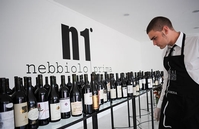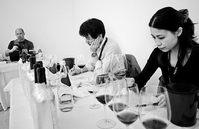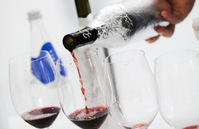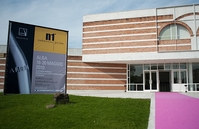If the doom-sayers are correct and we’re all in big trouble due to climate change, then we might as well have a giant party--with the drinks consisting of Nebbiolo-based wines from Italy’s Piedmont region. Without any doubt these wines have benefited more from warm growing seasons during the past 15 years than any other in the world, and without any hyperbole I can state that the wines on the market from this time span are quite simply the best in history.
This conclusion was driven home quite forcefully earlier this summer during intensive blind tastings of more than 300 new releases in Alba under the name, “Nebbiolo Prima.” These tastings are conducted over five days for about 50 writers from around the world in an ultra-professional manner. Three identical white rooms provide the setting, and all of the pouring performed by top Italian sommeliers, with roughly 65 wines presented each morning. I suspect that this isn’t everyone’s idea of a good time, but I regard this event as the finest of its kind in the world.
under the name, “Nebbiolo Prima.” These tastings are conducted over five days for about 50 writers from around the world in an ultra-professional manner. Three identical white rooms provide the setting, and all of the pouring performed by top Italian sommeliers, with roughly 65 wines presented each morning. I suspect that this isn’t everyone’s idea of a good time, but I regard this event as the finest of its kind in the world.
This month’s column includes all of the top wines that I tasted from Roero and Barbaresco, including DOCG wines from the 2008 vintage and Riserva bottlings from 2007 in Roero and 2006 in Barbaresco. Next month, I’ll be back with reviews of 2007 DOCG Barolos and 2005 Barolo Riservas.
Although you’ll find some excellent releases from Roero below, most of  the following reviews profile 2008 vintage wines from Barbaresco. I expected them to be less compelling than their forerunners from the 2007 vintage, which is more highly regarded in the region’s official ranking system. However, my scores were on average actually a little higher for the 2008s, which seems to stand as evidence of continuing improvement among the region’s producers.
the following reviews profile 2008 vintage wines from Barbaresco. I expected them to be less compelling than their forerunners from the 2007 vintage, which is more highly regarded in the region’s official ranking system. However, my scores were on average actually a little higher for the 2008s, which seems to stand as evidence of continuing improvement among the region’s producers.
To be more specific, my sense was not that the raw material in the 2008s was better than in the 2007 wines, but rather that the balance and integration was slightly better, and that the use of oak showed greater restraint. There was also evidence of better decisions having been made in vineyards, as fewer wines from 2008 showed signs of over-ripeness (though perhaps this is only because a cooler year in 2008 didn’t provide temptations comparable to those present at the end of the 2007 growing season). In any case, 2008 wines from Barbaresco are very, very strong, and it would be a bad mistake to let the lofty reputations of wines from 2006 and 2007 eclipse them.
To provide a bit of background on process, I tasted all of the wines below, blind, in five carefully conducted peer-group tastings. Every recommended wine was tasted at least twice, with a second evaluation performed before the identity of the wine was known to assure the accuracy of my score (since order of presentation can have a distorting effect). They are set forth below in order of excellence, with the highest-scoring wines topping the list.
effect). They are set forth below in order of excellence, with the highest-scoring wines topping the list.
When the producer’s name includes both a family and a given name, the family name usually appears first in order. This is a convention followed by the organizers of the Nebbiolo Prima tastings, though it is not one that was followed with perfect consistency. In a few instances I have taken the liberty of making corrections, but generally I have simply conveyed the producer names as designated in the tastings.
Names of particular vineyards and/or proprietary names of wines appear in quotation marks. The final element in the entries (following a comma and prior to a colon) is the name of the commune (or village) from which  the wine was sourced, which may be of interest to serious students of these wines and which rarely appears on labels.
the wine was sourced, which may be of interest to serious students of these wines and which rarely appears on labels.
Don’t fail to scroll down to find the four wonderful Barbaresco Riserva wines from 2006 at the bottom of this column. I’ll be back in four weeks with an even more extensive account of the top Barolo releases from 2007, a terrific vintage that produced wines that can be enjoyed relatively young while also capable of extended ageing.
Renato Buganza “Bric Paradis,” Guarene – Piobesi d’Alba: Rich, concentrated, deeply flavored and quite persistent, this shows lovely sweetness of fruit that easily counterbalances the tannins. 91
Cascina Val del Prete, Priocca: Impressive for its concentration, depth of flavor and persistence, this shows very attractive leathery and floral complexities and sweet fruit edged with fine-grained tannin. 91
Rabino F.lli, Santa Vittoria d’Alba: Engagingly perfumed, this is a very successful wine in a feminine style. A floral topnote leads into delicate fruit recalling both red and dark cherries. Structured by extremely fine-grained tannin, this is silky in feel and already highly enjoyable. 91
Casetta F.lli, Canale: This shows a level of complexity and refinement that could cause vintners in the Barolo and Barbaresco regions to suffer some sleepless nights. Scents of fresh flowers and baking spices get the wine off to a great start, and layered fruit with appealing sweetness that is beautifully balanced against subtle wood, integrated acidity, and fine-grained tannin. 92
Cascina Ca' Rossa “Monpissano,” Canale: Complex aromas and flavors made this wine stand out from the others in this day’s tasting, with soft texture and sweet flavors recalling dark cherries. The generous fruit effectively hides lots of tannin that will enable this to develop for at least another five years. 91
Malvirà “Mombeltramo,” Canale: An immediately appealing wine that also shows enough nuances to prove enduringly interesting, this is sweet and soft with persistent, layered flavors leading to an appropriately firm finish. 91
Orlando Abrigo “Rocche Meruzzano,” Treiso: I knew nothing of this producer, but found this wine so outstanding that I immediately arranged a visit to learn who was behind it. It proved absolutely extraordinary in richness, depth, integration and overall quality. The aromas were open and extremely expressive, showing exotic elements of Asian spice and cured meat, and the deep color was no mere tease, as the wine’s body was concentrated and deeply flavored but not chunky or over-ripe. There’s plenty of tannin, but it shows up very late in the finish, and will enable this to improve for several more years. Very, very impressive. 95
Montaribaldi “Palazzina,” Nieve: The 2007 Barbarescos from Montaribaldi were stunning last year, and this wine also stood out from the pack in the blind tastings of 2011. The style seems rather traditional, with moderate depth and darkness of color suggesting minimal use of new oak. However, the flavors run very deep, with exceptional tenderness and truly appealing texture even at this early stage of development. Sweet and pure, it shows amazing purity and coherence that hangs together through the finish without ever showing a crack. Just terrific. 94
Molino “Teorema,” Alba: This wasn’t the most expressive of the Barbarescos (Barbareschi?) in aromatic terms, but it was quite possibly the most compelling in flavor. Conspicuously dark in pigmentation, it follows through with exceptionally deep and persistent flavors that are structured by fresh acidity and subtle oak, as well as enough tannin to provide grip in the finish. The sweet fruit holds center stage throughout the performance, though a mineral (almost saline) character in the finish threatens to steal the show. 94
La Ca' Nova “Montestefano,” Barbaresco: Quite ripe, sweet and soft, with tannins that come in late but are very nicely buffered by the sweetness of the fruit. Very flavorful and expressive, yet adequately structured and serious, this is a wine that should prove highly enjoyable over a long span of time. Meaty, deeply flavored and long, but without any over-ripeness or stewey or oaky flaws, this is an exceptionally well made wine. 93
Rattalino “Quarantadue42,” Barbaresco: Sweet and very open and tender in both flavor and texture, this shows layered, long flavors and lots of character. Floral and fruity and leathery all at once, this is a model of complex character in the sexpot mode. 93
Montaribaldi “Sorì Montaribaldi,” Barbaresco: The 2008 releases from Montaribaldi may be even better than the 2007s, which were absolutely terrific. This is a big, meaty, muscular wine, and yet it shows beautiful balance and lots of mineral-laden complexities. The ample fruit and ample tannins are impressively proportionate to one another, and the wine achieves excellent integration despite its outsized components. 93
Cascina delle Rose “Tre Stelle,” Barbaresco: Sweet and inviting, with a very nice spicy edge. With its soft texture and sweet, open fruit, this seems luxurious by comparison to most of the wines in its category, and yet it never seemed formless or obvious or over-ripe. Very fine aromatics including notes of spices and licorice and smoked bacon, this was at once expressive and delicate. 92
Ca’ del Baio “Asili,” Barbaresco: Very sweet and juicy, with deep flavors and a lovely textural tenderness, this was among the most immediately inviting of all the Barbarescos shown. 92
Cascina Luisin “Sorì Paolin,” Nieve: Explosively fruity, with notes of candied cherries and red raspberries, this was a show-stopper. The flavors are fresh and pure, with very little overt oak influence. The tannins are ripe and unobtrusive, and the oak is admirably restrained, lending nuances of spice and smoke but not overloading the finish with wood tannins. Extremely appealing. 92
Produttori del Barbaresco, Barbaresco – Nieve: A performance at this level in the normale release from this cooperative producer is nothing short of astonishing. Woodsmoke shows in the aromas, but is actually overshadowed by floral scents, and the flavors display fruit that is sweet and primary but never over-ripe. Juicy and soft in texture, it retains its appeal through the finish, and though other wines in these tastings proved a little more complex, the wine availability and accessible price of this wine make it one of the most impressive releases from Barbaresco in the 2008 vintage. 91
Battaglio, Nieve: Red fruit aromas and flavors lead the way in this wine, but mineral and savory elements also show prominently, and the interplay between these notes is extremely appealing. Acidity and oak and tannin are all perceptible, yet they never obscure the lovely fruit or the other nuances that make this wine so endearing. 91
Marchesi di Barolo “Serragrilli,” Nieve: Although this wine is a little shy in terms or aroma, it shows impressive weight and depth of flavor, and will certainly develop into an outstanding example of Barbaresco with time for secondary aromas to develop. Beautifully proportioned and modestly oaked, this shows superb fruit quality. Anybody can claim that his wine was made in the vineyard, but this one walks the walk. 91
Piero Busso “Mondino,” Nieve: An exemplar of integration and coherence, this is soft in texture and very open and engaging in fruit profile, yet firm and serious as well, with subtle bracing from acidity and tannin and wood. Very convincing stuff. 91
Ca' du Rabajà, Nieve-Barbaresco: Generous and inviting, this is rich and layered, with fruit that seems concentrated but neither over-ripe nor over-extracted. Rounded in texture, it somehow manages to display no hard facets while still seeming structured. 91
Giacosa Fratelli “Basarin,” Nieve: Of all the 2008 Barbarescos shown in the Nebbiolo Prima tastings, this was perhaps the single most overtly fruity wine, with an intense red raspberry character deeply imbuing both the aromas and the flavors. This note is so intense that it overshadows other elements, making this a wine that might be in the second rank on grounds of complexity but is definitely at the head of the class in terms of sheer hedonistic appeal. 91
Cascina Luisin “Rabajà,” Barbaresco: Deeply sweet and inviting, with exotic scents of smoked meat, spices, licorice and menthol followed by juicy fruit-based notes recalling red cherries and raspberries. Rich and ripe but still focused and fresh. 91
Rinaldi Pietro “San Cristoforo,” Nieve: Soft and seductive, this is a sexpot wine with such luxurious depth and softness that it almost makes you want to climb into the glass to take a dip. The fruit is very ripe, and yet comes up just short of seeming stewed. I wondered if there was an insufficiency of acidity and tannin to keep this in balance, but that question faded on a second taste, whereas the sheer pleasure provided by the wine did not. 91
Fontanabianca “Bordini,” Nieve: Restrained oak speaks softly in this wine, with ripe fruit notes leading the aromatic impression and soft, sweet cherry notes prominent in the initial flavors. Seeming at once open but also structured, this is very nicely balanced, with authoritative tannins making themselves felt only late in the wine’s finish. 91
Francone “I Patriarchi,” Nieve: Coherent and balanced already at this early stage, this shows a lot of oak initially but there’s plenty of soft, sweet fruit to achieve balance. 91
Punset “Campo Quadro,” Nieve: Highly expressive aromas are thoroughly charming, with appealing mineral and savory notes showing very prominently in the mélange of flavors, along with accents of spice and wild herbs on the core of dark cherry fruit. This is certainly not among the richest of the 2008 Barbarescos, but is very generous despite its rather modest frame. 91
Cascina Bruciata “Rio Sordo,” Barbaresco: Like 1996, 2006 produced Nebbiolo-based wines that will unwind rather slowly, but they also have a lot of nuances to unwind, and that is a fine recipe for success in the Riserva category. This terrific wine is exceptionally complex in both aroma and flavor, with delicate notes of dark cherries and berries, mint, licorice, spices and smoke interlaced beautifully so that each can be sensed as a distinct element. There’s plenty of wood and tannin to provide framing, but the sweetness of the fruit is very much in evidence, and this has a long run ahead of it. 95
Nada Giuseppe “Casot,” Treiso: To be sure, there’s lots of oak showing in this wine, but amazing sweetness of fruit to counterbalance it, and lots of subtle spice and savory accents to lend interest. A few other Riservas were a bit more concentrated and weighty, but this was especially impressive for how persistent its flavors proved to be, with the fruit never yielding pride of place to the tannins in the long, symmetrical finish. Bloody impressive wine. 94
Castello di Nieve “Santo Stefano,” Nieve: This is notably more developed at this stage than the other top Riservas, and consequently not a wine to sock away in the cellar but rather one to check in the next couple of years. Notes of saddle leather and baking spices are wonderfully appealing, with plenty of soft, sweet fruit backing them up before the finish is firmed by ripe, fine-grained tannin. 93
Castello di Verduno “Rabajà,” Barbaresco: Ripe and rich and full of engaging flavors, this shows lots of fruit and lots of supporting structure. Built for the long haul, this isn’t yet as expressive as its more developed counterparts in the Riserva category from 2006, but all of the material needed for a long ascent is clearly incorporated in the wine, and with time to develop, this will clearly achieve impressive heights. 93